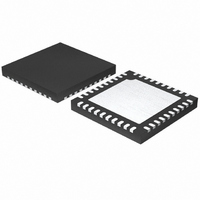ISL6564CR Intersil, ISL6564CR Datasheet - Page 19

ISL6564CR
Manufacturer Part Number
ISL6564CR
Description
IC CTRLR PWM MULTIPHASE 40-QFN
Manufacturer
Intersil
Datasheet
1.ISL6564IRZ.pdf
(27 pages)
Specifications of ISL6564CR
Pwm Type
Voltage Mode
Number Of Outputs
1
Frequency - Max
1.5MHz
Duty Cycle
66.7%
Voltage - Supply
4.75 V ~ 5.25 V
Buck
Yes
Boost
No
Flyback
No
Inverting
No
Doubler
No
Divider
No
Cuk
No
Isolated
No
Operating Temperature
0°C ~ 70°C
Package / Case
40-VFQFN, 40-VFQFPN
Frequency-max
1.5MHz
Lead Free Status / RoHS Status
Contains lead / RoHS non-compliant
Available stocks
Company
Part Number
Manufacturer
Quantity
Price
Company:
Part Number:
ISL6564CRZ-T
Manufacturer:
REELDATE
Quantity:
67 500
Company:
Part Number:
ISL6564CRZ-T
Manufacturer:
INTERSIL/PB-FREE
Quantity:
4 000
Undervoltage Detection
The undervoltage threshold is set at 75% of the VID code.
When the output voltage at VSEN is below the undervoltage
threshold, PGOOD gets pulled low.
Overvoltage Protection
When VCC is above 1.4V, but otherwise not valid as defined
under Power on Reset in Electrical Specifications, the
overvoltage trip circuit is active using auxiliary circuitry. In
this state, an overvoltage trip occurs if the voltage at VSEN
exceeds 1.8V.
With valid VCC, the overvoltage circuit is sensitive to the
voltage at VDIFF. In this state, the trip level is 1.7V prior to
valid enable conditions being met as described in Enable
and Disable. The only exception to this is when the IC has
been disabled by an overvoltage trip. In that case the
overvoltage trip point is VID plus 200mV. During soft-start,
the overvoltage trip level is the higher of 1.5V or VID plus
200mV. Upon successful soft-start, the overvoltage trip level
is 200mV above VID. Two actions are taken by the ISL6564
to protect the microprocessor load when an overvoltage
condition occurs.
At the inception of an overvoltage event, all PWM outputs
are commanded low instantly (less than 20ns) until the
voltage at VSEN falls below 0.6V with valid VCC or 1.5V
otherwise. This causes the Intersil drivers to turn on the
lower MOSFETs and pull the output voltage below a level
that might cause damage to the load. The PWM outputs
remain low until VDIFF falls to the programmed DAC level
when they enter a high-impedance state. The Intersil drivers
respond to the high-impedance input by turning off both
upper and lower MOSFETs. If the overvoltage condition
VDIFF
FIGURE 12. POWER GOOD AND PROTECTION CIRCUITRY
REFERENCE
DAC
75%
VID + 0.2V
UV
AND CONTROL LOGIC
+
-
SOFT START, FAULT
OV
19
EACH CHANNEL
REPEAT FOR
OC
+
-
OC
+
-
110µA
I
1
PGOOD
OVP
110µA
I
AVG
ISL6564
reoccurs, the ISL6564 will again command the lower
MOSFETs to turn on. The ISL6564 will continue to protect
the load in this fashion as long as the overvoltage condition
recurs.
Simultaneous to the protective action of the PWM outputs,
the OVP pin pulls to VCC delivering up to 100mA to the gate
of a crowbar MOSFET or SCR placed either on the input rail
or the output rail. Turning on the MOSFET or SCR collapses
the power rail and causes a fuse placed further up stream to
blow. The fuse must be sized such that the MOSFET or SCR
will not overheat before the fuse blows. The OVP pin is
tolerant to 12V (see Absolute Maximum Ratings), so an
external resistor pull up can be used to augment the driving
capability. If using a pull up resistor in conjunction with the
internal overvoltage protection function, care must be taken
to avoid nuisance trips that could occur when VCC is below
2V. In that case, the controller is incapable of holding OVP
low.
Once an overvoltage condition is detected, normal PWM
operation ceases until the ISL6564 is reset. Cycling the
voltage on EN or ENLL or VCC below the POR-falling
threshold will reset the controller. Cycling the VID codes will
not reset the controller.
Overcurrent Protection
ISL6564 has two levels of overcurrent protection. Each
phase is protected from a sustained overcurrent condition on
a delayed basis, while the combined phase currents are
protected on an instantaneous basis.
In instantaneous protection mode, the ISL6564 takes
advantage of the proportionality between the load current
and the average current, I
condition. See the Channel-Current Balance section for
more detail on how the average current is measured. The
average current is continually compared with a constant
110µA reference current as shown in Figure 10. Once the
average current exceeds the reference current, a
comparator triggers the converter to shutdown.
In individual overcurrent protection mode, the ISL6564
continuously compares the current of each channel with the
same 110µA reference current. If any channel current
exceeds the reference current continuously for eight
consecutive cycles, the comparator triggers the converter to
shutdown.
AVG
, to detect an overcurrent
December 27, 2004
FN9156.2












